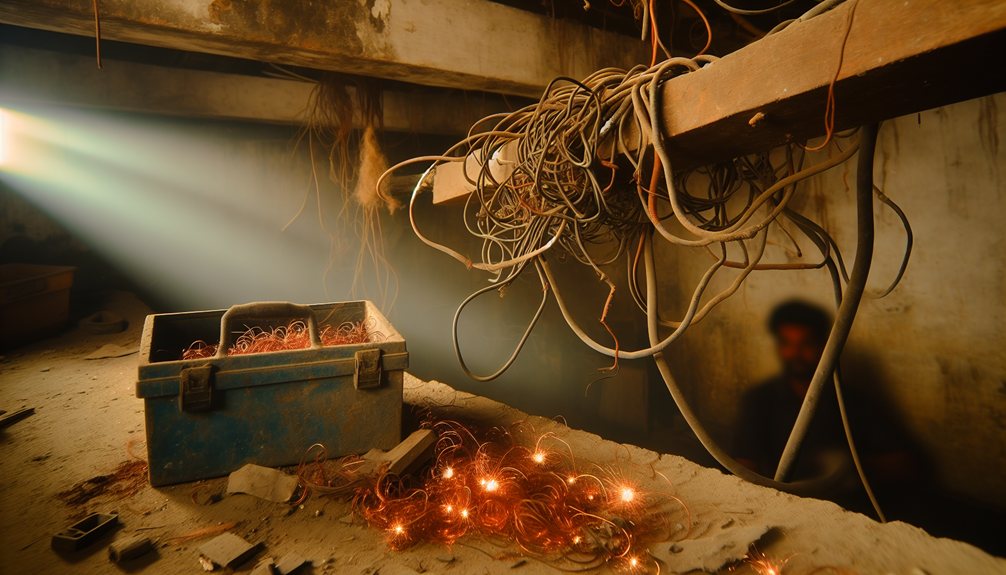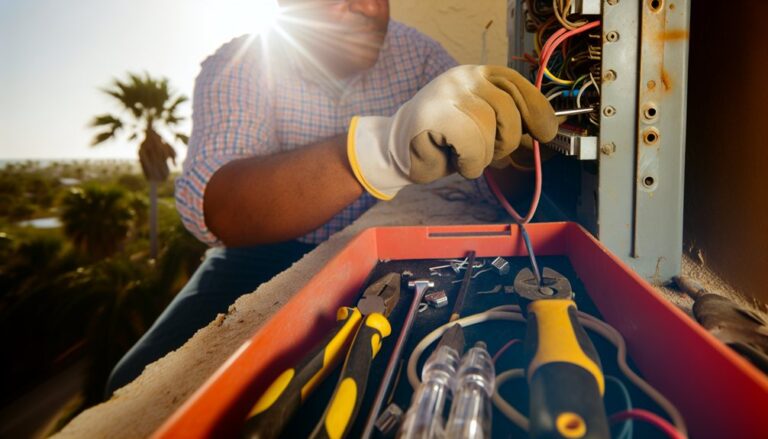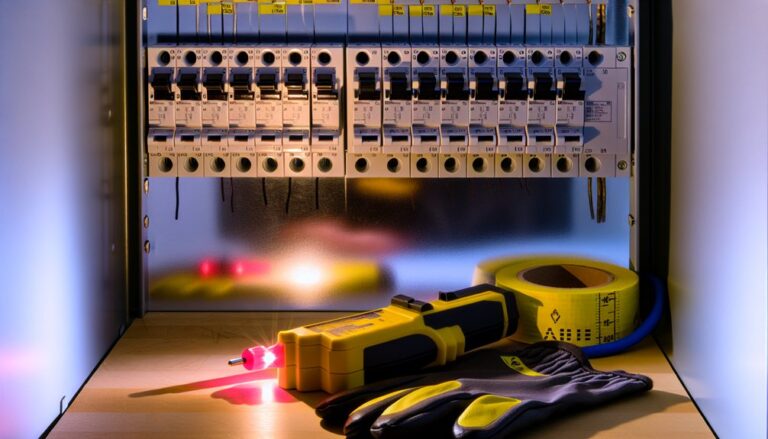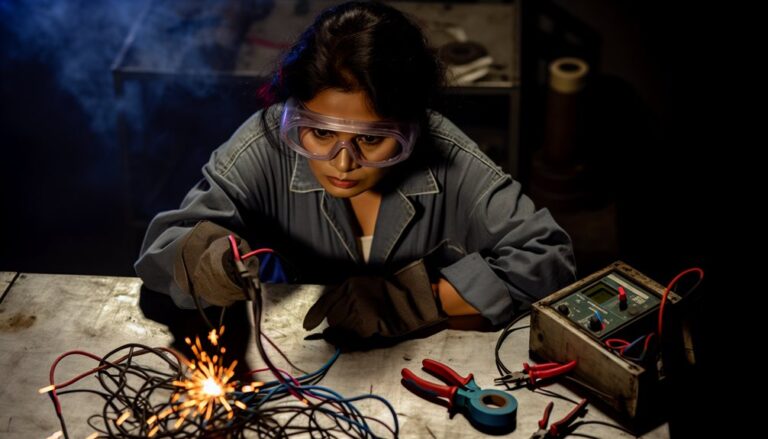Addressing Poor Wiring Issues
Addressing poor wiring issues requires immediate attention to prevent safety hazards. Look for flickering lights, warm outlets, or frequently tripped breakers, which indicate underlying problems. Always prioritize proper insulation and use quality materials to avoid circuit overloads. Regular inspections every few years guarantee compliance with safety standards and longevity of your system. While you might consider DIY fixes, hiring a licensed electrician usually provides a thorough assessment and safer solutions. There’s more to explore on maintaining electrical safety at home.
Key Takeaways
- Inspect wiring regularly to identify wear and ensure compliance with electrical codes, ideally conducting visual checks annually.
- Address flickering lights and warm outlets promptly to prevent potential overheating and fire hazards.
- Avoid DIY electrical repairs; hire a licensed electrician for accurate assessments and safe solutions.
- Replace old or inferior wiring materials to reduce resistance and improve circuit safety.
- Schedule circuit load assessments every three years to confirm adequate capacity and prevent overloads.
Understanding Common Wiring Problems
When you encounter wiring issues, it’s crucial to recognize the common problems that can arise.
One significant concern involves the quality of wiring materials used. Inferior materials often lead to increased resistance and heat, which can escalate into circuit overloads. These overloads occur when the current exceeds the capacity of the wiring, potentially causing damage and fire hazards.
Additionally, improper connections and inadequate insulation can further contribute to these issues, creating a dangerous environment.
You should also be aware of the age of the wiring system, as older installations may not meet current safety standards.
Understanding these common wiring problems will help you assess your situation and take necessary action to guarantee safety and reliability.
Identifying Signs of Poor Wiring
Recognizing signs of poor wiring is essential for maintaining safety in your home or workplace. You should pay attention to flickering lights, as they often indicate inconsistent power flow or overloaded circuits.
If you notice outlets that feel warm to the touch or show signs of discoloration, these burnt outlets suggest potential overheating or short circuits. Additionally, if you frequently experience tripped circuit breakers, it may signal underlying wiring issues.
Unusual buzzing sounds from outlets or switches can also be a red flag. Finally, if you find yourself using multiple extension cords to power devices, this could indicate inadequate circuit capacity.
Addressing these signs promptly can help prevent more severe electrical hazards.
The Risks of Ignoring Wiring Issues
Ignoring wiring issues can lead to severe consequences that jeopardize both safety and property. When you overlook these problems, you increase the risk of fire hazards greatly.
Faulty wiring can overheat, sparking fires that can quickly engulf your home, endangering lives and possessions. Beyond safety concerns, there are serious financial implications.
Repairing damage from electrical fires can cost thousands, not to mention the potential loss of your home’s value. Additionally, insurance claims related to fire damage can lead to higher premiums or denial of coverage altogether.
Importance of Regular Electrical Inspections
Regular electrical inspections play a pivotal role in maintaining the safety and functionality of your home’s wiring system. By adhering to established electrical codes, you can guarantee compliance and prevent potential hazards. Inspection frequency typically depends on your home’s age and usage, but annual checks are generally advisable.
| Inspection Aspect | Recommended Frequency | Importance |
|---|---|---|
| Visual Wiring Check | Annually | Identifies visible wear |
| Circuit Load Assessment | Every 3 years | Guarantees safe load capacity |
| Grounding System Review | Every 5 years | Confirms safety against shocks |
Staying proactive with inspections not only enhances safety but also extends the lifespan of your electrical system, preventing costly repairs down the line.
DIY Solutions vs. Professional Help
While tackling wiring issues on your own can seem appealing, understanding the limitations of DIY solutions is essential.
DIY techniques may offer immediate fixes for minor problems, but they often lack the precision and safety that professional expertise provides. Without formal training, you might misdiagnose issues, leading to further complications. In addition, incorrect installations can pose significant safety hazards, such as electrical fires or system failures.
On the other hand, enlisting professional help guarantees a thorough assessment of your wiring issues. Licensed electricians possess the knowledge and tools to identify underlying problems and implement lasting solutions.
Ultimately, weighing the risks and benefits of each approach will guide you in making an informed decision about how to address your wiring concerns effectively.
Upgrading Outdated Wiring Systems
As technology evolves, upgrading outdated wiring systems becomes essential to guarantee safety and efficiency in your home.
Older wiring may not handle the electrical load required by modern appliances, increasing the risk of malfunctions and hazards. By implementing wiring upgrades, you confirm your system can accommodate current demands.
Utilizing modern materials like copper and upgraded insulation reduces the likelihood of overheating and short circuits. Additionally, these materials improve conductivity, enhancing overall performance.
Before starting any upgrades, evaluate your existing wiring and consult a licensed electrician for expert advice.
They can identify necessary improvements tailored to your specific needs, assuring that your home remains safe, functional, and compliant with current electrical codes.
Prioritizing these upgrades can greatly enhance your home’s electrical reliability.
Best Practices for Electrical Safety at Home
Upgrading your wiring system greatly improves safety, but adhering to best practices for electrical safety at home is equally important.
To prevent circuit overloads and guarantee the effectiveness of grounding techniques, follow these guidelines:
- Use surge protectors for sensitive electronics.
- Regularly inspect cords and outlets for signs of wear.
- Avoid daisy-chaining multiple devices on one outlet.
- Guarantee all outlets are properly grounded.
- Install GFCI outlets in high-moisture areas like kitchens and bathrooms.
About Us
We understand that electrical issues can be stressful and overwhelming. That’s why we are here to lend a helping hand and provide you with the best electrical services in town. As a team of experienced electricians, we take pride in our ability to solve any electrical problem with precision and care.
Pages
Follow us
Electrician Fort Lauderdale Today
Fort Lauderdale, FL 33301
© 2025 By Electrician Fort Lauderdale Today







